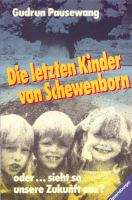The Last Children of Schewenborn facts for kids

German edition cover
|
|
| Author | Gudrun Pausewang |
|---|---|
| Country | Germany |
| Language | German |
| Genre | Drama |
|
Publication date
|
1983 |
| Media type | Print (Hardback and paperback) |
The Last Children of Schewenborn (German: Die letzten Kinder von Schewenborn) is a book written in 1983 by Gudrun Pausewang. It tells the story of life in a small German town after a nuclear war. A nuclear war is when powerful bombs are used, causing huge destruction.
Even though the story is made up, Pausewang shared that she based the town of Schewenborn on a real place. It was inspired by Schlitz in East Hesse, Germany, where she used to live.
Contents
What the Story is About
The story takes place during a time like the Cold War. This was a period when countries were very tense, but without direct fighting. The book is told from the view of Roland, a 12-year-old boy. He lives in Bonames, a part of Frankfurt.
Roland's Journey and the Attack
Roland is traveling with his parents and sisters to visit his grandparents. They are heading to the town of Schewenborn. During their trip, something terrible happens. They are caught in a nuclear attack.
After the attack, emergency help does not arrive. No one comes to offer aid. The people who survived start to think that all of Germany, or even the whole world, might be destroyed. The book keeps you wondering if this is true until the very end.
Life After the Bombs
Roland's family finds safety in his grandparents' house. His grandparents were in Fulda when the bombs hit. It is believed they did not survive. Soon after, Roland's mother takes in two young children. They are a brother and sister who lost their parents in the attack.
The rest of the book describes the weeks, months, and even years that follow. Most of the story happens in Schewenborn.
The Difficult Ending
The Last Children of Schewenborn does not have a happy ending. One by one, members of Roland's family get sick and die. This includes a new baby born without eyes. They suffer from radiation sickness and other illnesses.
By the end of the book, only Roland, his father, and a small group of children are left. These children are the "last children" mentioned in the title. The final pages suggest that they might not survive much longer either.
Important Messages in the Book
The book is like a cautionary tale. This means it is written to give a serious warning. It wants to warn both everyday people and world leaders. It is similar to other books that show a future where things have gone very wrong.
Who the Book is For
This book is especially for young readers. Because of its important message, it was often on reading lists in schools. Many teenagers around the eighth grade in West German states read it.
Other Books with Similar Ideas
Gudrun Pausewang wrote another famous book called Die Wolke. It has a similar theme. Both books share a feeling of dark, coming danger. This feeling was common among people in the German Environmentalist Movement during the 1980s.
Awards the Book Won
- Buxtehuder Bulle, 1983
- Zürcher Kinderbuchpreis (Zürich children's literature prize)
- Preis der Leseratten
- Gustav-Heinemann-Friedenspreis (Gustav Heinemann peace prize)

